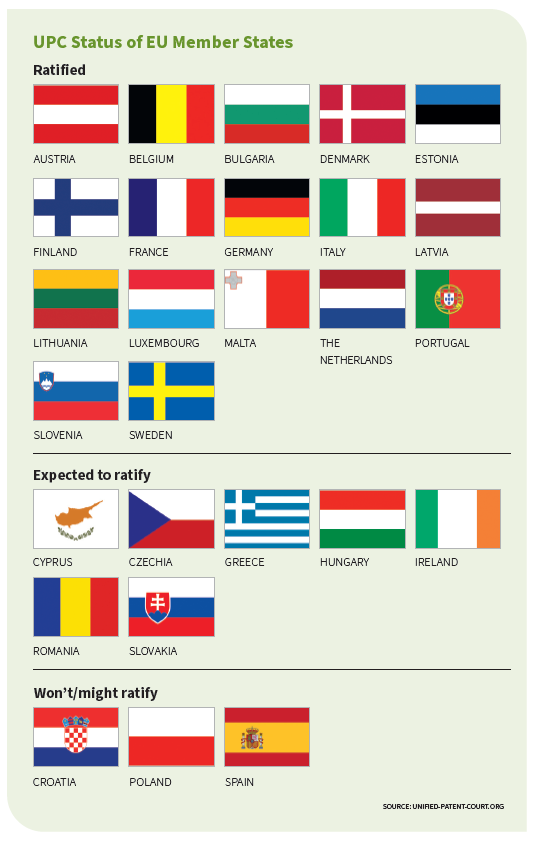International Litigation: Litigating Patents in Europe: A Whole New Ball Game
Publication | 01.10.24
It’s a whole new ball game for European patent ligation: The Unified Patent Court opened for business on June 1, 2023.
U.S. companies and other patent holders doing business in Europe—and their lawyers—stand to benefit greatly. “Previously, patent cases had to be filed in individual countries,” says Kristof Roox, a Brussels-based partner in Crowell & Moring’s Intellectual Property Group. “The establishment of the UPC means that cases are filed in one court whose jurisdiction extends to all countries that are signatories to the UPC Agreement (UPCA). One set of laws applies instead of many, and costs are lower.”
Pre-UPC: A patchwork system
European patents are granted by the European Patent Office under the 1973 European Patent Convention. Patents granted by the EPO are known as classic European patents, or EPs.
This system has considerable limitations, however. Chief among them is that an EP is a bundle of national patent rights and, consequently, patent litigation takes place on an individual-country basis. Each country not only has its own laws and courts, but also has its own patent renewal fees and official language(s) for proceedings and translation. The outcome of litigation in any one country has little to no impact on litigation in any other country.
The result is a fragmented, patchwork system governing European patents that is inconsistent, costly, and highly impractical. It favors deep- pocketed parties that can afford to litigate potentially lengthy matters in multiple jurisdictions.
What is UPC?

The UPC is an international court whose legal basis is the UPCA, which is an intergovernmental treaty that was signed by 25 EU members in 2013. Only EU members can participate in the UPC; all have signed the UPCA except Croatia, Poland, and Spain. Of the 27 EU members today, 17 have ratified the UPCA (see table, page 27) and the remaining seven members are expected to do so eventually.
As part of the new system, the EPO can now also grant European patents with unitary effect known as UPs (unitary patents).
The UPC’s structure is simultaneously simple and complex, notes Roox. The simplicity lies in the fact that there are two levels of courts, the Court of First Instance (i.e., lower court) and the Court of Appeal. But things get complicated with the Court of First Instance, which has three divisions.
There are 13 local, country-specific divisions in 10 countries (Germany has four local divisions due to the historically large volume of patent cases in its courts). The regional division comprises Estonia, Latvia, Lithuania, and Sweden, which have agreed to have their cases heard in Stockholm. Infringement claims can be brought in the local/regional divisions of the UPC where the infringement has occurred or where the defendant is located.
The central division adjudicates patent revocations (i.e., invalidations), with certain exceptions. Its main seat is in Paris, with additional seats in Munich and Milan, and its work is divided according to the subject matter of the patent in dispute. Three countries that aren’t in a local or regional division—Bulgaria, Luxembourg, and Malta— bring actions in the central division.
The Court of Appeal is in Luxembourg and hears appeals of decisions by the Court of First Instance. Both the Court of First Instance and the Court of Appeal can file requests for preliminary ruling on questions about EU law with the Court of Justice of the European Union.
Jurisdiction and transitional period
The UPC has exclusive jurisdiction over EPs and UPs. During a seven-year transitional period that started when the UPCA went into force (and which may be extended by up to seven years), actions relating to EPs may alternatively be brought before national courts or other competent national authorities.
EPs can be opted out of the UPC’s jurisdiction in the transitional period. Patent holders can even opt out EPs and then opt back in if they want to take advantage of the UPC system. Once national proceedings related to an opted-out EP have started, however, the opt-out cannot be withdrawn. The UPC has exclusive jurisdiction over UP applications, which cannot be opted out of.
There was concern among potential plaintiffs that the court would set high standards for granting injunctions, but that doesn’t seem to be happening.
— Kristof Roox
A bright future
Given the UPC’s brief existence, it’s difficult to draw solid conclusions about its effectiveness. There is limited case law, of course, and low transparency, as technical problems have prevented the UPC registry from publishing many cases and rulings.
Roox nonetheless is optimistic about the court’s viability and prospects.
“We’ve seen fair, well thought-out, quality judgments so far,” he says. “Trials and judgments have also been speedy. There was concern among potential plaintiffs at first that the court would set high standards for granting injunctions, but that doesn’t seem to be happening.
“Because defendants seem to find the judgments well balanced, companies might reconsider their opt-outs and nonparticipating EU member states may decide to ratify the UPCA. All of these are important factors that should help attract a much higher volume of litigation,” he says.
Compelling for U.S. parties
The fact that the UPC combines legal uniformity with large size and scale is especially compelling for U.S.-based parties, Roox adds. Patent holders now have a straightforward, cost-effective way to seek protection and to access the huge European market. Smaller parties that have shied away from the country-by-country system can bring or defend cases with greater ease and confidence.
While U.S. (i.e., non-EU) lawyers cannot appear in UPC proceedings, they can play a much larger and more important role in European patent litigation than before. This is because parties can choose the languages in which actions are conducted and translated.
Assuming—as many observers do— that English will usually be one of the languages, U.S. firms will be able to draft substantive arguments and know that their writing will be accurately understood. There likely will be an increase in the number of U.S. firms that are partnering with EU firms on UPC cases.
Contacts
Insights
Publication | 03.01.26
Publication | 01.15.26
Publication | 01.07.26
Publication | 01.05.26



